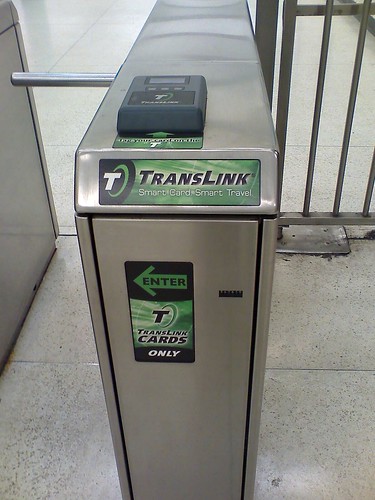
Muni Metro has an infamous reputation, from the classic "Muni Meltdown" (the ATC program that failed), and the train cars that break down often.
Now Muni can add another notorious item to it. Translink.
Unfortunately, Translink card readers that are an add-on accessory to the "exit" fare gates at metro stations and are really weak versus the readers in operation on vehicles and the stationary readers at places like the Golden Gate Ferry terminals (SF and Larkspur).
Here is now I describe the metro station gate readers as slow:
- Translink cards are RFID, meaning you can place the card in your wallet or purse (as long as it is within an appropriate proximity). On bus readers, you can stick your card in front of several plastic cards and a small bunch of dollar bills in your wallet, and it will read your card. On the metro gates, you would have to pull your card out of your wallet and tag it "bare" or stick it in something with much fewer layers between the reader and card.
- They don't respond quickly when tagged (even if done "bare"). Vehicle and stationary readers respond quickly when tagged correctly. Proof is shown in this video I did with the "Translink party" (see below). The video shows quick tagging on the vehicle reader, but poor reading on the gate.
Conclusion: The readers on the metro gates are way underpowered.
However, while underpowered, they are reliable to open the gates for entry when you get the green light, and there's no more hassling the station agent by tagging the reader in front of the booth. With the stimulus money, Muni plans to replace the gates in the future.
I'm right now traveling in Japan and bought a Suica smart card for travel around the Japan Rail East network. It's great. It reads as soon as you touch it on the reader. It's really incredible to watch the masses of people entering the railway stations and everyone using their smart cards. The card also works on several transit agencies, like the subway and bus systems in the Tokyo Metropolitan area.
ReplyDeleteThe Tokyo Metro has its own smart card called the Pasmo, yet the Pasmo and Suica are pretty much interchangeable with a few minor differences, so you can use the Suica on the Tokyo Metro and the Pasmo on the JR East Railways. It's great how they were able to integrate the two smart card systems together.
What's even better is that many vending machines and stores nearby transit stations accept the Suica and Pasmo for payment. It's not as extensively used in retail as the Octopus Card in Hong Kong, but I was still very impressed with the set-up of the smart cards here.